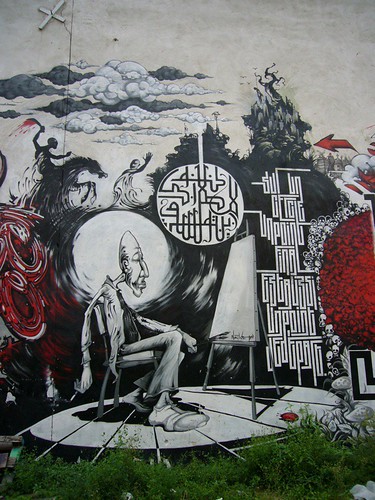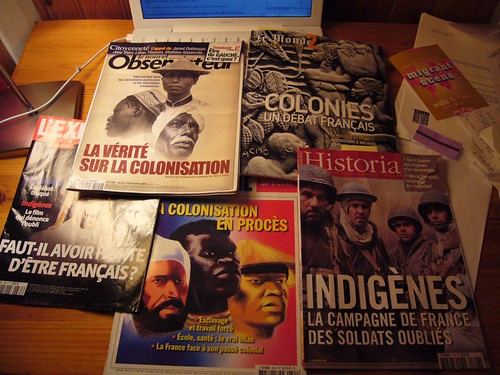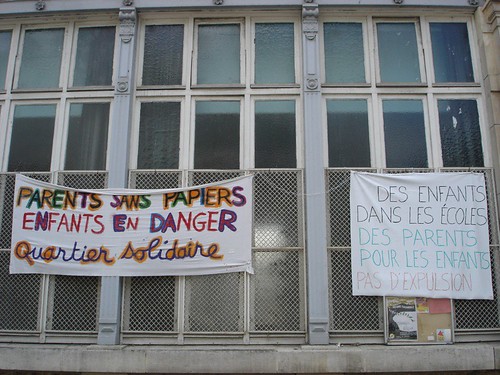11/01/07
Intermezzo

Parisian street art - an example of appropriation of space
This blog has been rather quiet for a long time now. Despite a steady increase of half finished, and half started, posts, they’ve not yet found their way to the web. My lack of inspiration for blog writing has perhaps been due to the intermezzo-like character of the autumn. I’ve for the most part stayed in Oslo, trying to reintegrate into the office environment at the university after having been autonomous fieldworker for almost two semesters. In terms of writing and reading, and even thinking, the reintegration has not been very fruitful. One of the few things I’ve got around to do, was to present my research so far at a handful of occasions. Writing and getting feedback on these presentations (they don’t deserve the term “paper”), I’ve come up with a few themes to focus my attention around. As this intermezzo is coming to an end and I’ll get on with phase two of my fieldwork, this is a suitable occasion for a little summary.
I’m suggesting that the French slam poetry scene is creating a site, or space, for popular resistance and cosmopolitan co-existence. When I once briefly mentioned to a colleague that I focused on resistance, she asked “resistance to what?” “The state,” I replied, looking a bit surprised, thinking by myself: what else to resist. However, it’s of course more complicated than that, and I’ll have to be far more specific and concrete in my description. It’s not simply “the state”, and the slam poetry is about far more than just resistance. Moreover, of course, as good anthropology, I’ll now have to show, i.e. evocatively describe, how such a space – for popular resistance and cosmopolitan co-existence – is created. Here I’ll have to look into the performances themselves, within the context of the slam soirée. I’ve started thinking about what makes some recitals good and others not. It’s something about the force of the performance, it’s “trueness” or “authenticity”… Don’t ask me yet what I mean by this.
That the slam scene is cosmopolitan was one of the determining factors when I chose to focus my research on it, as cosmopolitanism was what I came to Paris to study in the first place. Initially, I found Paris (and France) to be undeniably postcolonial, but surprisingly segregated and surprisingly little cosmopolitan. The broader socio-political context, within which I’ll situate the slam scene, I’m thinking of analysing in terms of a postcolonial reappropriation of time as well as space:

Indication of the postcolonial reappropriation of French history...
It seems to me to be a postcolonial reappropriation of French history taking place at the moment. I also wonder if one can say that there is a postcolonial reappropriation of space taking place in areas like Eastern Paris. – Shops, ways of dressing and ways of using the public space, are just a few examples. The constant mobilisation for the sans-papiers, with demonstrations, posters, banners outside schools for instance…, is another. Street art and graffiti appear to me to be a visual equivalent to the slam poetry – both are concentrated in the popular east side of the city and both are taking art to the people where the people are. I’ve shot several hundred photos of street art just wandering around, but now I’m considering doing a more systematic research.

Postcolonial reappropriation of space in East Paris
So, the plan for the next months is to focus on slam poetry, urban landscape, popular resistance and perhaps a little bit of street art. (As an envious professor said to me when he heard that I was going to Paris for eight months to study slam poetry: “If [the leader of the far right party] knew what you’re doing with the tax payers money…”. (To be honest, it’s not the Norwegian taxpayers who’re paying this time as I’ve taken leave without pay from my Ph.D. post, but a scholarship from a charitable and art loving Frenchman by the name Georges Sautreau.)
2 comments
Hi Cicilie,
It sounds like you’ve been more productive than you think you have! It sounds like your project is starting to become much more focused. I think your theory about a ‘reappropriation’ of the colonial past is very interesting too, but there is something about this issue that puzzles me. I agree that in 2005 and 2006 this issue was really at the top of the media agenda but it seems to me to have rather disappeared in recent months (since September maybe, and the release of Indigenes). The movement ‘Les Indigenes de la Republique’ has totally disappeared, for example. I’m not saying the interest has disappeared altogether, any more than I would argue that it was a ‘new’ phenomenon in 2005 (look at the lyrics on older albums from groups like ‘La Rumeur’ or ‘Zebda’) but when I talk to people about it there’s often a sense of fatigue, a feeling of “haven’t-we-had-this-debate-now?” (No!). And what if anything has changed? Or, perhaps more to the point, how do we guage this change? And how do I test my hunch that this initial wave of interest has passed?
I look forward to reading more about your fieldwork and seeing more of your wonderful photos. Good luck!
Mary.
Hi Mary, Thanks for your nice and very interesting comment. I particularly appreciated it since you know far more about the public discourses concerning the colonial past than I do. (Luckily for me, your thesis will be finished and available for me to read before I finish my own ![]() ).
).
I agree with you that this is not a new phenomenon; another example to the ones you mention is the long struggle for public recognition of the substantial contribution of the slaves themselves in the abrogation of slavery (mentioned for instance in Black skin, French voices, a monograph about the Antillais in Metropolitan France by David Beriss. I think the anthropologist Michel-Rolph Trouillot has treated the issue of official silence in the history of slavery as well as the Haitian revolution extensively). And perhaps you’re right that this postcolonial re-appropriation reached its preliminary peak last year, somewhere between the release of Indigènes the film and Chirac’s speech to “all the children of the republic” during the November 2005 riots, not to mention the abrogation of the law paragraph on teaching the “positive sides of French colonial presence”. I have no idea what will happen next. I can imagine many people feeling good about having “had the discussion now”, but my guess would rather be that it’s quiet before the storm concerning Europe’s legacy…
Methodologically the big question is, as you point out; how can we capture such possible, or perhaps lack of, profound changes in our predominantly synchronic research? I faced a similar situation in my research amongst British Asians in London. However, at the time, I had no qualms in claiming that “Britishness” had become more inclusive during the 1990s. I based my argument mainly on my informants’ stories of how they perceived the changes from the time they grew up. These brief lifestories, I compared to (half) fictional growing-up stories from the 1960s by Meera Syal and Hanif Kureishi, as well as other ethnographic material. Luckily, my informants’ opinions weren’t unanimous: some would claim that the positive changes were only due to marketing strategies for getting hold of the “brown pound” or some “Blair-right” shallow “cool Britannia” transformation. The situation in France, on the other hand, I find far more confusing, so for the moment, I have no idea how to answer your question. But, I’m looking very much forward to discussing it further with you.
Cicilie
| « Rue du Faubourg du Temple | Social geography – Place de la République » |

